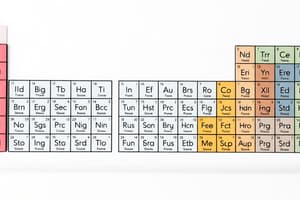Podcast
Questions and Answers
What type of atoms are involved in covalent bonding?
What type of atoms are involved in covalent bonding?
- Metal and metal
- Two non-metal (correct)
- Metal and non-metal
- Two metal
What is the main purpose of VSEPR theory in chemistry?
What is the main purpose of VSEPR theory in chemistry?
- Identifying metals
- Predicting bond angles in molecules (correct)
- Calculating ionization energy
- Determining atomic radius
Which of the following is a periodic trend?
Which of the following is a periodic trend?
- Constant ionization energy
- Random electron configuration
- Increasing atomic radius (correct)
- Decreasing number of valence electrons
In chemical periodicity, what does the periodic table organize elements according to?
In chemical periodicity, what does the periodic table organize elements according to?
What do covalent bonds form when electrons do?
What do covalent bonds form when electrons do?
What is the role of electrons in predicting the characteristics of chemical bonds?
What is the role of electrons in predicting the characteristics of chemical bonds?
What does chemical periodicity refer to?
What does chemical periodicity refer to?
Who first introduced the concept of chemical periodicity?
Who first introduced the concept of chemical periodicity?
What does the Valence Shell Electron Pair Repulsion (VSEPR) theory explain?
What does the Valence Shell Electron Pair Repulsion (VSEPR) theory explain?
How does chemical periodicity help chemists predict element behaviors?
How does chemical periodicity help chemists predict element behaviors?
What does the VSEPR theory predict about molecules?
What does the VSEPR theory predict about molecules?
How do core principles of chemical bonding help scientists?
How do core principles of chemical bonding help scientists?
Study Notes
Periodic Properties and Chemical Bonding
In chemistry, understanding the relationship between atomic structure and the behavior of elements is crucial. This knowledge leads us to the study of periodic properties and chemical bonding, which help us classify various types of bonds and predict their characteristics based on the position of atoms within the periodic table. Let's explore these concepts by delving into covalent bonding, periodic trends, chemical periodicity, and VSEPR (Valence Shell Electron Pair Repulsion) theory.
Covalent Bonding
Covalent bonding occurs when two non-metal atoms share electrons to achieve a stable electron configuration. In this case, the outermost shells have enough valence electrons to fill all orbitals. Covalent bonds form when electrons from both nuclei are transferred to each other's orbitals, creating shared electron pairs.
Periodic Trends
The periodic table organizes elements according to their atomic numbers, which correspond to the number of protons in their nucleus. This arrangement allows chemists to identify patterns among elements called periodic trends. These trends include increasing atomic size, ionization energy, and many others depending on where we look in the periodic table. For example, going across a row in the periodic table, you will find that atomic radius increases because electrons occupy larger orbitals further away from the nucleus.
Chemical Periodicity
As mentioned earlier, chemical periodicity refers to repeating patterns observed within groups of elements in the periodic table. It helps chemists anticipate similarities in element behaviors due to having equal numbers of valence electrons, resulting in similar reactivity, properties, and interactions with other elements. This concept was first introduced by Dmitri Mendeleev who recognized that there were recurring themes amongst elements in different parts of his newly developed periodic table. Today we understand more deeply why certain elements behave similarly based on their electron configurations and orbital arrangements.
VSEPR Theory
The Valence Shell Electron Pair Repulsion (VSEPR) model explains how electron pairs around a central atom arrange themselves in space to minimize repulsions among them. This principle applies regardless of whether they're bonded or lone pairs. As such, it can help predict the shape of molecules containing multiple bonds, like NH3 (ammonia), CH4 (methane), etc., whose shapes vary widely despite being composed only of carbon and hydrogen.
This brief overview just skims the surface of what makes up periodic properties and chemical bonding. However, these core principles allow scientists to explain phenomena ranging from alkalies burning brightly to noble gases barely interacting with anything at all. They enable predictions regarding compound formation and reactions, helping us better understand our world and beyond.
Studying That Suits You
Use AI to generate personalized quizzes and flashcards to suit your learning preferences.
Description
Explore the fundamental principles behind periodic properties and chemical bonding in chemistry, including covalent bonding, periodic trends, chemical periodicity, and VSEPR theory. Understand how these concepts help predict the behavior and interactions of elements based on their atomic structure and position in the periodic table.




